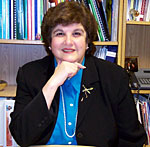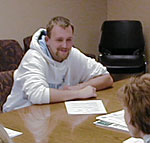By Tim Pugmire
Minnesota Public Radio
October 21, 2002
In 1975, President Ford signed landmark legislation that guaranteed every disabled child equal access to an education. Congress will soon begin work to reauthorize the Individuals with Disabilities Education Act (IDEA). This complex law has opened up learning opportunities for millions of children. But it's also consistently criticized as the classic unfunded mandate, one that puts a financial drain on school districts.
| |
|
|
|
||
At Lake Harriet Community School in Minneapolis, every student participates in physical education. Fourth grader Sam Graves needs an electric wheelchair to get around, but despite physical disabilities, he's playing soccer along side his nondisabled classmates. Physical education teacher Nancy Ostmoe says inclusion is the name of the game.
"Each activity has its own set of challenges, so it's just different for every activity, but we try to make sure he's included in everything, in every aspect," Ostmoe said.
Before 1975, students like Sam were largely absent from gym class as well as regular classrooms. An estimated 1 million disabled students were at least partly excluded from public schools. Other children floundered with undetected learning handicaps.
Former Minnesota Gov. Al Quie represented Minnesota's 1st District in 1975. He was also the ranking Republican on the House committee that shaped the law that would later become the Individuals with Disabilities Education Act (IDEA).
"At that time there were a number of young people who really needed special help who were falling through the cracks," Quie said. "The legislation we had at the time did not sufficiently provide help for them, and I just felt strongly that we needed to make that next step."
The IDEA was that next step - a mandate that all disabled children have access to a free and appropriate education. It also mandates they be educated with nondisabled children in regular classrooms to the greatest extent possible.
The U.S. Department of Education says about six million students nationwide are now enrolled in special education programs. In Minnesota, the count is 114,000. Their impairments range from traumatic brain injuries to emotional behavioral disorders.
|
"Kids who 20 years ago would not have qualified or fallen under the special education umbrella, today do." - David Jennings, Minneapolis Public Schools
|
Paula Goldberg is executive director of the PACER Center in Bloomington, an organization that's been helping parents of disabled children understand their legal rights since 1978. Goldberg says IDEA has been remarkably successful.
"Because of this law, attitudes have changed in our society," Goldberg said. "Children are not placed in institutions anymore. Children have higher expectations of themselves, and parents and teachers know that kids can learn."
Under the federal law, teachers and parents meet annually to set expectations under a student's "Individualized Education Program," or IEP. This plan includes specific learning goals and outlines the special services needed to meet those goals. It also requires extensive paperwork, which many educators find overwhelming.
Teachers, counselors and other advisors gave mostly positive feedback to Mike Thielen during his recent IEP meeting. Thielen, 19, is unable to read or write. He's technically a student at Coon Rapids High School, but he spends all of his class time at Hennepin Technical College learning auto body repair. Thielen is enrolled in a transitional work program for older students with special needs. He says the alternative learning approach has help turn his life around.
"I like going to school now, and it's fun," Thielen said. "And I've got more possibilities to better myself in life, and get a degree and get out in the industry and make money."
Jane Johnson, an advocate from the PACER Center has helped Mike and his family navigate the special education rules for more than five years. She says she helped Mike push the system by spelling out an alternative learning program and support services in his IEP.
| |
|
|
|
||
"It is a legal contract and the school is obligated provide what is identified in the contract," Johnson said. "And they are identified based on the students' needs. Mike has always needed a note taker. He does so much better if things are read to him."
Parents and school officials don't always agree on the IEP, and those conflicts can lead to litigation. State records show there were 114 complaints filed in the 2000-2001 school year. Of those, 31 cases were mediated and 16 required full blown hearings.
Norena Hale, with the special education division of the Minnesota Department of Children, Families and Learning, says school districts are obligated to provide an appropriate education regardless of cost.
"All the way from fully integrated into the regular classroom, to maybe a resource room if a child needs to be pulled out for say an hour a day to get extra help," Hale said. "All the way to some children may be in a separate class for the full school day. And then there would be some children who actually receive 24-hour services."
To meet the requirements, school districts must hire sufficient numbers of speech pathologists, physical therapists, counselors and other specialists. The U.S. Department of Education estimates the total annual cost of special education at $51 billion. Minnesota spends more than $980 million.
Since 1975, the federal government has promised to pay up to 40 percent of the excess cost. But over 27 years the special education subsidy has never topped 15 percent. David Jennings is chief operating officer for the Minneapolis school district.
"The result of that in Minneapolis is a $27 million deficit between what it costs us to meet the federal requirement and the amount of money that's provided by the federal government to accomplish that," Jennings said.
State funding fills much, but not all, of the gap. That leaves districts to find ways to pay for the mandate. Jennings says as the cost of special education grows, districts find they must siphon off money needed for general education purposes.
Specials education costs in Minnesota are rising nearly six percent annually. Jennings says one big factor is the broadening definition of special education.
"So kids who 20 years ago would not have qualified or fallen under the special ed umbrella, today do," Jennings said. "And so it's partly being driven by changes in what society perceives to be a learning disability, or what research suggests might be a learning disability."
For example, state records show more than 3,700 students in Minnesota identified as autistic last year. Ten years earlier, the count was just 331.
Some researchers and reformers claim too many students have been wrongly identified as learning disabled. They say many of those students were just never taught properly how to read. Other critics point to the disproportionate number of minority students in special education, particularly too many African American males.
Despite the law's overall success, education reformers say the unintended, negative consequences of IDEA must be addressed by Congress during its reauthorization.
More from MPRMore Information


